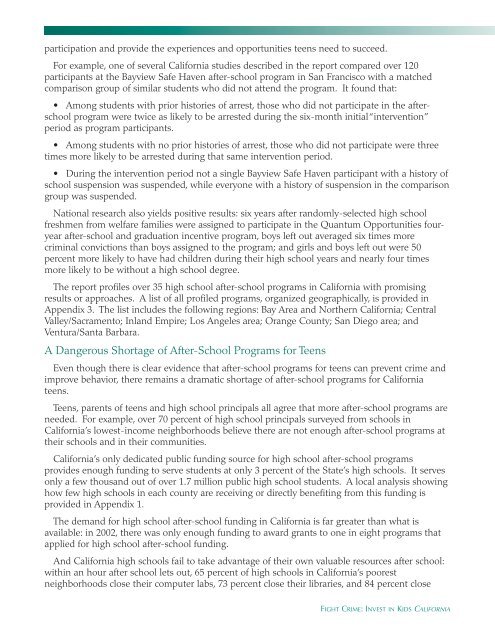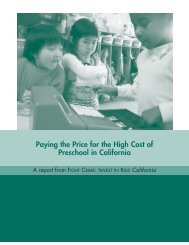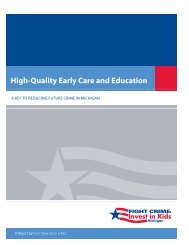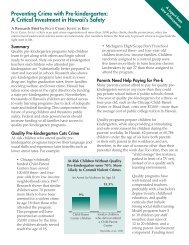California's Next After-School Challenge - Fight Crime: Invest in Kids
California's Next After-School Challenge - Fight Crime: Invest in Kids
California's Next After-School Challenge - Fight Crime: Invest in Kids
You also want an ePaper? Increase the reach of your titles
YUMPU automatically turns print PDFs into web optimized ePapers that Google loves.
participation and provide the experiences and opportunities teens need to succeed.<br />
For example, one of several California studies described <strong>in</strong> the report compared over 120<br />
participants at the Bayview Safe Haven after-school program <strong>in</strong> San Francisco with a matched<br />
comparison group of similar students who did not attend the program. It found that:<br />
• Among students with prior histories of arrest, those who did not participate <strong>in</strong> the afterschool<br />
program were twice as likely to be arrested dur<strong>in</strong>g the six-month <strong>in</strong>itial “<strong>in</strong>tervention”<br />
period as program participants.<br />
• Among students with no prior histories of arrest, those who did not participate were three<br />
times more likely to be arrested dur<strong>in</strong>g that same <strong>in</strong>tervention period.<br />
• Dur<strong>in</strong>g the <strong>in</strong>tervention period not a s<strong>in</strong>gle Bayview Safe Haven participant with a history of<br />
school suspension was suspended, while everyone with a history of suspension <strong>in</strong> the comparison<br />
group was suspended.<br />
National research also yields positive results: six years after randomly-selected high school<br />
freshmen from welfare families were assigned to participate <strong>in</strong> the Quantum Opportunities fouryear<br />
after-school and graduation <strong>in</strong>centive program, boys left out averaged six times more<br />
crim<strong>in</strong>al convictions than boys assigned to the program; and girls and boys left out were 50<br />
percent more likely to have had children dur<strong>in</strong>g their high school years and nearly four times<br />
more likely to be without a high school degree.<br />
The report profiles over 35 high school after-school programs <strong>in</strong> California with promis<strong>in</strong>g<br />
results or approaches. A list of all profiled programs, organized geographically, is provided <strong>in</strong><br />
Appendix 3. The list <strong>in</strong>cludes the follow<strong>in</strong>g regions: Bay Area and Northern California; Central<br />
Valley/Sacramento; Inland Empire; Los Angeles area; Orange County; San Diego area; and<br />
Ventura/Santa Barbara.<br />
A Dangerous Shortage of <strong>After</strong>-<strong>School</strong> Programs for Teens<br />
Even though there is clear evidence that after-school programs for teens can prevent crime and<br />
improve behavior, there rema<strong>in</strong>s a dramatic shortage of after-school programs for California<br />
teens.<br />
Teens, parents of teens and high school pr<strong>in</strong>cipals all agree that more after-school programs are<br />
needed. For example, over 70 percent of high school pr<strong>in</strong>cipals surveyed from schools <strong>in</strong><br />
California’s lowest-<strong>in</strong>come neighborhoods believe there are not enough after-school programs at<br />
their schools and <strong>in</strong> their communities.<br />
California’s only dedicated public fund<strong>in</strong>g source for high school after-school programs<br />
provides enough fund<strong>in</strong>g to serve students at only 3 percent of the State’s high schools. It serves<br />
only a few thousand out of over 1.7 million public high school students. A local analysis show<strong>in</strong>g<br />
how few high schools <strong>in</strong> each county are receiv<strong>in</strong>g or directly benefit<strong>in</strong>g from this fund<strong>in</strong>g is<br />
provided <strong>in</strong> Appendix 1.<br />
The demand for high school after-school fund<strong>in</strong>g <strong>in</strong> California is far greater than what is<br />
available: <strong>in</strong> 2002, there was only enough fund<strong>in</strong>g to award grants to one <strong>in</strong> eight programs that<br />
applied for high school after-school fund<strong>in</strong>g.<br />
And California high schools fail to take advantage of their own valuable resources after school:<br />
with<strong>in</strong> an hour after school lets out, 65 percent of high schools <strong>in</strong> California’s poorest<br />
neighborhoods close their computer labs, 73 percent close their libraries, and 84 percent close<br />
FIGHT CRIME: INVEST IN KIDS CALIFORNIA





